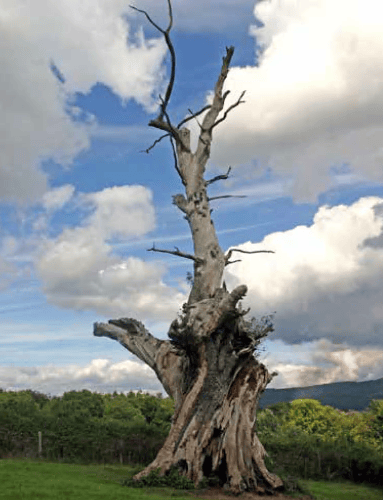There used to be more oak trees in Great Britain than any other tree and it is one of the reasons why England once ‘ruled the waves’.
HMS Victory for example, was constructed from over 6,000 oak trees and the song ‘Hearts of Oak’ is the official march of the Royal Navy. It is a remarkable fact that an English oak tree can live for 1,000 years and can grow over 35 metres tall.
It can be said that our great oaks are the crown jewels of our green inheritance. Of all our native hardwoods such as beech, ash, willow, it is the oak that grows largest, lives longest and has contributed most to our history.
The tallest oak recorded in Britain (the Whitfield Oak in Herefordshire) was 140ft tall when it was crippled by a thunderbolt and that’s the height of a 12 storey building. The biggest girthed living oak is probably the Bowthorpe Oak in Lincolnshire, which is 42ft when measured 5ft from the ground. There is enough room inside the hollow trunk for half a dozen people to dine in comfort and this was done as far back as the 18th century.
The main reason for the oak’s extraordinary longevity is that its wood is as tough as old boots. Pardon the pun, but old boots, like all leather goods, were treated with tannin and this chemical came from oak bark stripped from the trees.
One of Monmouthshire’s most impressive oak trees used to stand on the Golynos estate and it was accordingly known as the Golynos Oak. This estate is now the site of Newport Golf Club at Great Oaks Park, Rogerstone which founded in 1903 is 300 feet above sea level.
The Golynos Oak tree was massive, with a trunk 9ft. 7 in diameter and an overspread of 452 square yards. It was estimated to contain 2426 cubic feet of timber and the bark, 3 inches thick, alone was estimated to weigh 6 tons.
Unfortunately, trespass caused by the large number of visitors who came to see this very special oak tree, exasperated the owner of the estate, and he decided that it should be cut down.
In 1810, previous to it being felled the tree was divested of its brushwood, which was placed as a bed, to prevent the timber from bursting when it fell. It was felled in separate parts, and stages were erected for the workmen to stand on to cut off the six larger limbs, each of which was as large as an ordinary oak.
The main trunk was so large that no saw could be found long enough to cut through it; so two saws were brazed together. In cutting it through, a stone was discovered six inches in diameter, six feet from the butt, and three feet in a diametrical direction from the rind, round which the timber was perfectly sound.
There were four hundred concentric rings in its butt and as it had ceased to add to these for at least 100 years, so it was surmised that the tree was 500 hundred years old.
Five men were engaged for twenty-one days, stripping and cutting the tree down and a pair of sawyers were constantly employed for 138 days in its conversion. The total cost of felling, stripping and sawing, exclusive of superintending the conversion or haulage of any part of it was £82.
The timber was purchased by Thomas Harrison, purveyor of Plymouth dockyard and Dean Forest for 100 guineas. Listed in cubit feet, the timber was as follows: Main trunk- 450, six limbs–472, 355, 235, 156, 113, 106, six small limbs–413 and the dead limbs–126; giving a total of 2426 cubic feet.
A neighbouring landowner, Sir Charles Marshland commented that he would have given double the sum the oak fetched to have it saved from destruction. He had spent many a happy hour under its wide-spread crown, when presiding over the social picnic parties of which he was the life and soul in his younger days.
Many a time had he led the dance, until the night winds whispering in the branches warned them to retreat. No, he would never forget those days, nor forgive the sacrilege that brought that tree to the ground.
The timber was largely used for building ships for the Royal Navy and from the root exquisite pieces of furniture were made, including an inlaid round table which used to be in Llanover Court, the home of Lord and Lady Llanover.
Another important oak tree in Monmouthshire is the Caeryder Oak, in the Usk Valley, near the village of Llanhennock. The Newport historian Fred Hando measured the trunk with a tape measure in 1964, one foot above the ground and recorded a circumference of 48 feet.
It had previously been measured in 1876, when the circumference, one foot from the ground was 38.5 feet. The spread of its branches at that time was 126 feet and its height 70 feet.
Fred noted that ‘every crevice, every crack in the mighty structure was lined with moss which clothed trunk and branches in a brilliant acid green while the shadows hold purple and brown.
One enormous scar marked the breaking away, two years ago, of one of the biggest branches.’ He had heard that it was also known as the ‘Coronation Oak’ and Colonel Dean who lived near by, at Glenusk, showed him a coloured print which depicted celebrations being held under the tree in 1837, when Victoria ascended the throne.
‘On a chair near the trunk sat a harpist, in bardic robes, who may have come from Llanover. The men, several of them wearing hats, were dressed in light-frocked two button coats, but they were merely a foil to the graceful women, each wearing a “Dolly Vardon” hat, shawl, bodice and long skirt.’
This huge tree was probably a mere sapling when Queen Elizabeth I came to the throne and it lasted right through the reign of Elizabeth II.
It had been grown from an acorn and having witnessed so much over the passing centuries, would have been able in October 2010 to observe he Ryder Cup Golf Tournament being played on a specially constructed course at the Celtic Manor on the other side of the river Usk.
No, the tournament was not named after the tree, or the strange coincidence that it stands in a field called Cae Ryder (Ryder Field). This biennial tournament for male teams from Europe and the United States is actually named after
the English businessman Samuel Ryder who donated the trophy. The event when held in Monmouthshire was the first time it was played in Wales and was described as the ‘greatest ever on this side of the Atlantic’.
I have visited the Caeryder Oak several times during the last four decades and my pictures show how it has sadly deteriorated during this time but I was not there to photograph the tree when it finally fell in December 2021 having been dead for many years.






Comments
This article has no comments yet. Be the first to leave a comment.